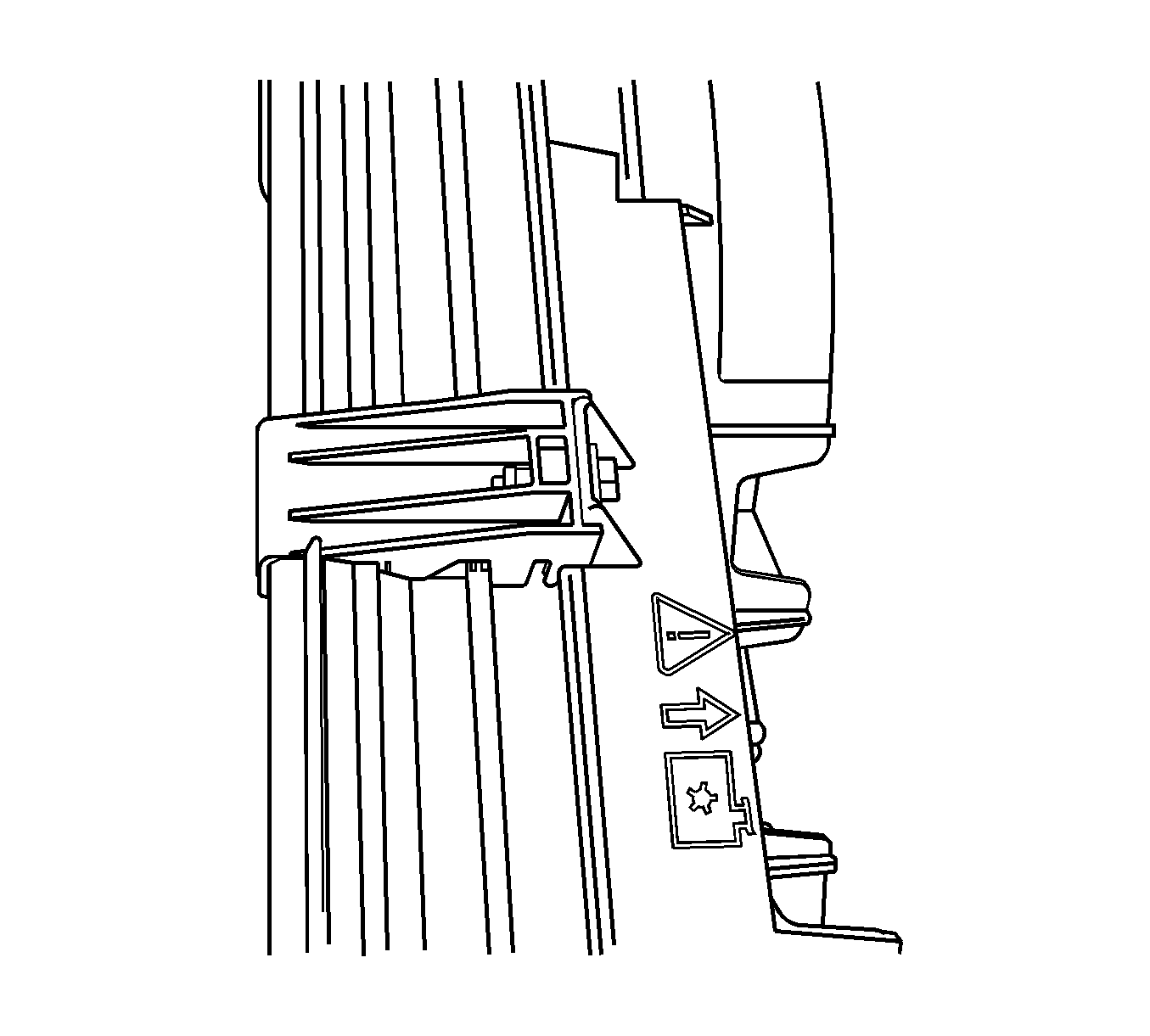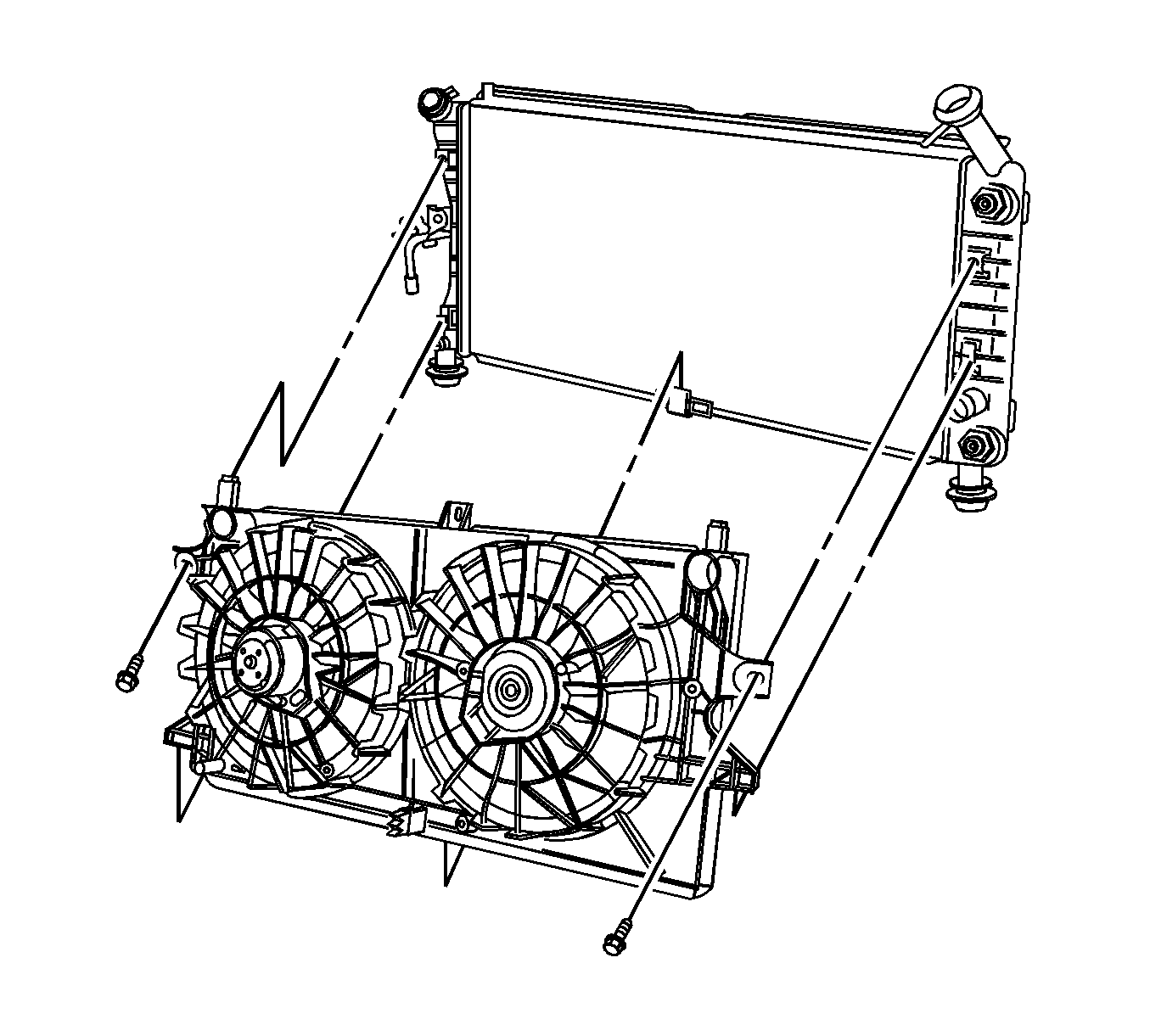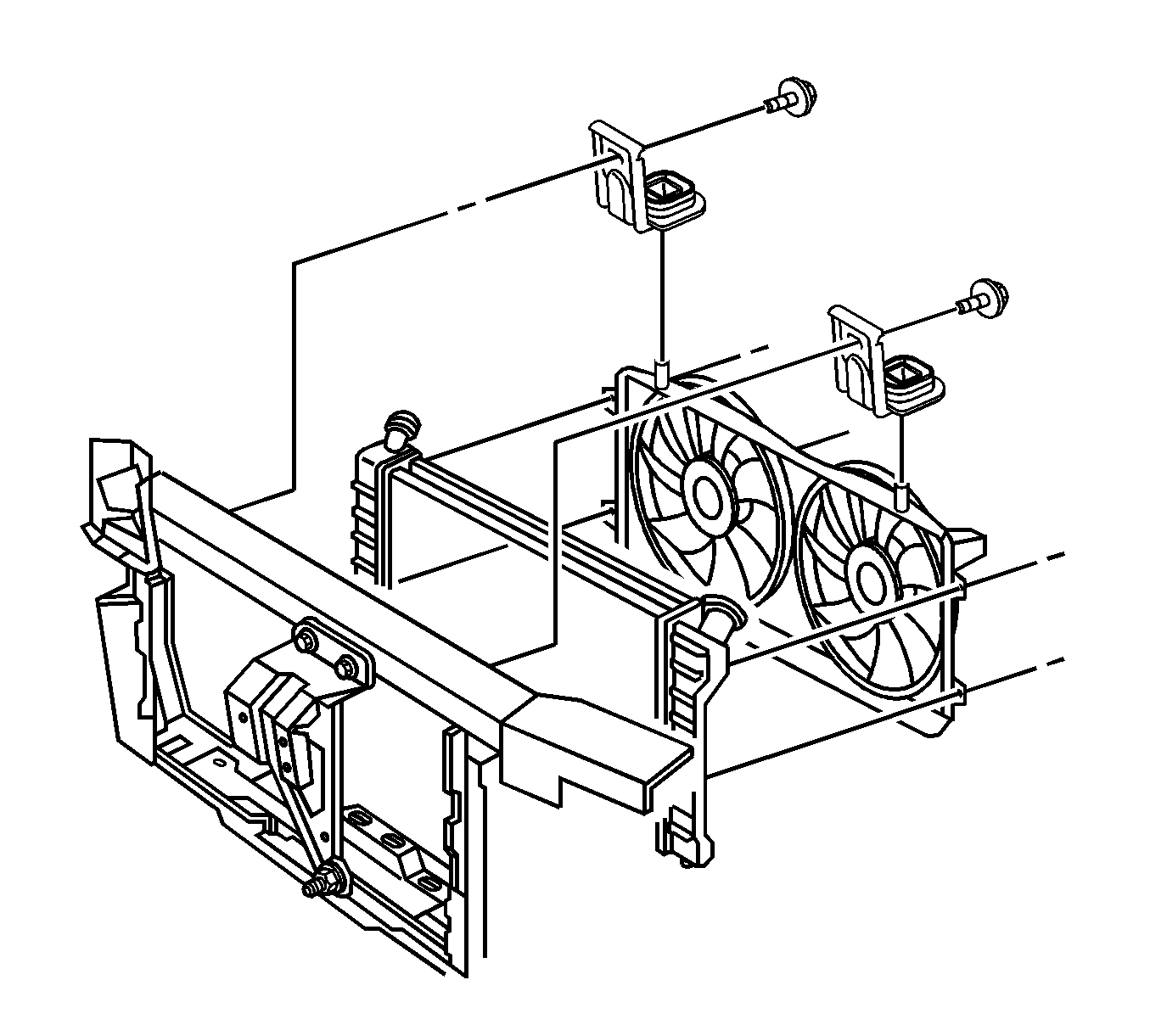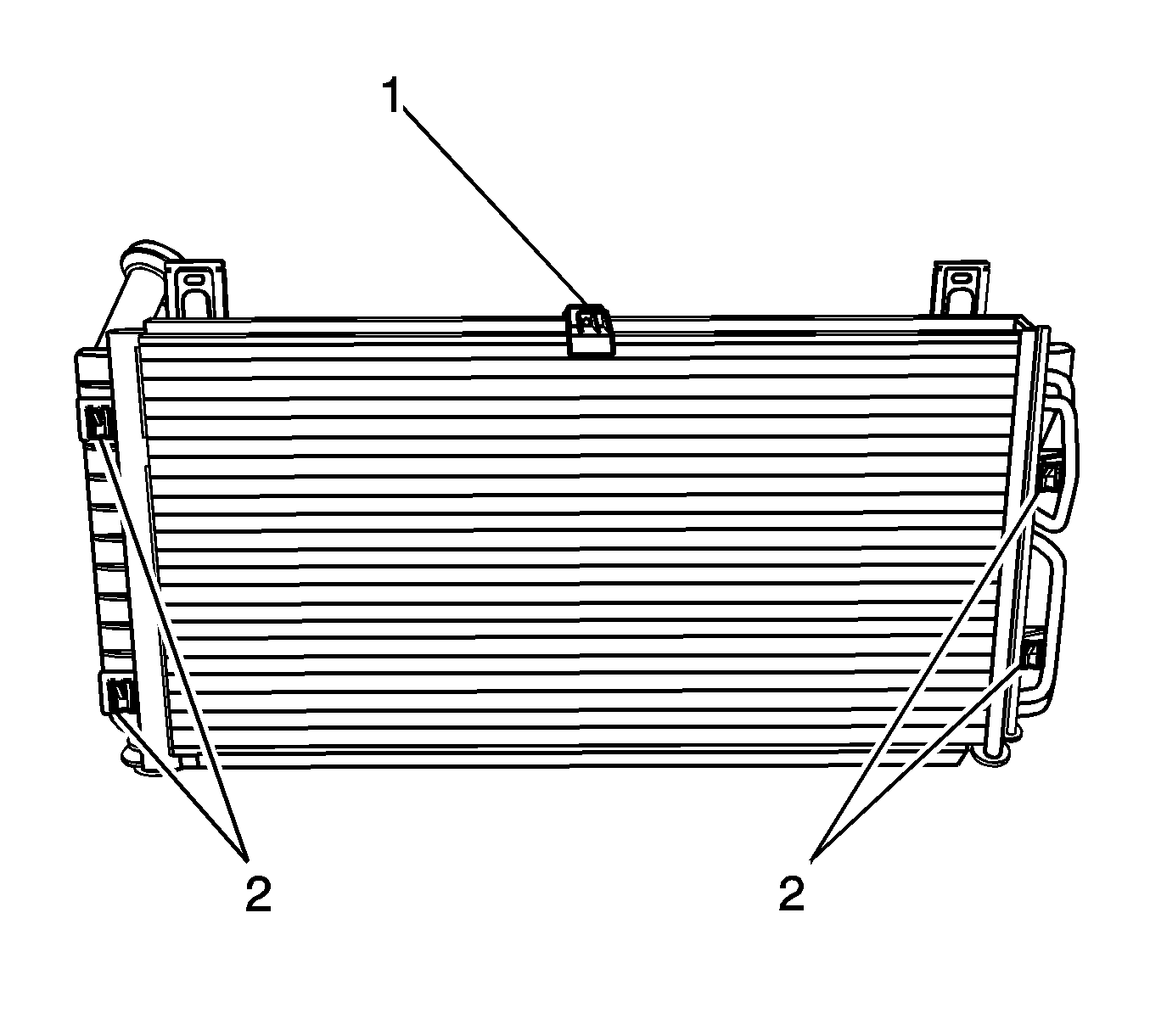Tools Required
J 38185 Hose Clamp Pliers
Removal Procedure
- Remove the battery. Refer to Battery Replacement in Engine Electrical.
- Remove the air cleaner assembly. Refer to Air Cleaner Assembly Replacement in Engine Controls-3.8L or Air Cleaner Assembly Replacement in Engine Controls-3.4L.
- Drain the cooling system. Refer to Cooling System Draining and Filling .
- Remove the right and the left engine mount struts. Refer to the following procedures:
- Use J 38185 to remove the inlet hose clamp from the radiator.
- Remove the inlet hose from the radiator.
- Remove the transmission oil cooler lines from the retainer clip at the bottom of the cooling fan shroud.
- Remove the bolt that connects the fan shroud to the condenser hold down bracket.
- Remove the cooling fan shroud bolts.
- Remove the coolant reservoir hose from the radiator overflow neck.
- Remove the radiator upper support brackets and bolts that connect to the fan shroud.
- Disconnect the engine cooling fan motors electrical connector.
- Remove the cooling fan motors electrical harness from the fan shroud clips.
- Remove the cooling fan shroud.
- Remove the bolt from the condenser tube support bracket to the radiator.
- Use J 38185 to remove the outlet hose clamp from the radiator.
- Remove the outlet hose from the radiator.
- Disconnect the transaxle oil cooler pipes from the radiator. Refer to Transmission Fluid Cooler Hose/Pipe Quick-Connect Fitting Disconnection and Connection in Automatic Transaxle - 4T65 - E.
- Tilt the top of the radiator rearward.
- Remove the condenser hold down bracket (1) from the radiator.
- Remove the air deflectors from the top of the radiator.
- Lift the condenser from the mounting tabs on the radiator (2). Position the condenser aside.
- Remove the radiator.
Caution: Unless directed otherwise, the ignition and start switch must be in the OFF or LOCK position, and all electrical loads must be OFF before servicing any electrical component. Disconnect the negative battery cable to prevent an electrical spark should a tool or equipment come in contact with an exposed electrical terminal. Failure to follow these precautions may result in personal injury and/or damage to the vehicle or its components.
| • | Engine Mount Strut Replacement - Left Side in Engine Mechanical-3.4L |
| • | Engine Mount Strut Replacement - Left Side in Engine Mechanical-3.8L |





Installation Procedure
- Install the radiator to the lower mounts.
- Install the condenser to the mounting tabs on the radiator (2).
- Install the condenser hold down bracket (1) to the radiator and condenser.
- Install the air deflectors to the top of the radiator.
- Install the outlet hose to the radiator.
- Use J 38185 to install the outlet hose clamp to the radiator.
- Connect the transaxle oil cooler pipes to the radiator. Refer to Transmission Fluid Cooler Hose/Pipe Quick-Connect Fitting Disconnection and Connection in Automatic Transaxle - 4T65 - E.
- Install the bolt for the condenser tube support bracket to the radiator.
- Install the cooling fan shroud.
- Install the cooling fan motors electrical harness to the fan shroud clips.
- Connect the engine cooling fan motors electrical connector.
- Install the cooling fan shroud bolts.
- Install the radiator upper support brackets and bolts that connect to the fan shroud.
- Install the bolt that connects the fan shroud to the condenser hold down bracket.
- Install the inlet hose to the radiator.
- Use J 38185 to install the inlet hose clamp to the radiator.
- Install the air cleaner assembly. Refer to Air Cleaner Assembly Replacement in Engine Controls-3.8L or Air Cleaner Assembly Replacement in Engine Controls-3.4L.
- Install the coolant reservoir hose to the radiator overflow neck.
- Install the right and left engine mount struts. Refer to the following procedures:
- Install the transmission oil cooler lines to the retainer clip at the bottom of the cooling fan shroud.
- Fill the cooling system. Refer to Cooling System Draining and Filling .
- Install the battery. Refer to Battery Replacement in Engine Electrical.
- Adjust the transaxle fluid level.


Important: Verify that the condenser is fully seated in the radiator mounting tabs.
Notice: Use the correct fastener in the correct location. Replacement fasteners must be the correct part number for that application. Fasteners requiring replacement or fasteners requiring the use of thread locking compound or sealant are identified in the service procedure. Do not use paints, lubricants, or corrosion inhibitors on fasteners or fastener joint surfaces unless specified. These coatings affect fastener torque and joint clamping force and may damage the fastener. Use the correct tightening sequence and specifications when installing fasteners in order to avoid damage to parts and systems.
Tighten
Tighten the bolts to 10 N·m (89 lb in).

Important: Ensure the lower edge of the fan shroud engages the clip at the bottom of the radiator.
Tighten
Tighten the bolts to 10 N·m (89 lb in).

Tighten
Tighten the bolts to 10 N·m (89 lb in).

Tighten
Tighten the bolt to 6 N·m (53 lb in).
| • | Engine Mount Strut Replacement - Left Side in Engine Mechanical-3.4L |
| • | Engine Mount Strut Replacement - Left Side in Engine Mechanical-3.8L |
Notice: Do NOT overfill the transaxle. The overfilling of the transaxle causes foaming, loss of fluid, shift complaints, and possible damage to the transaxle.
